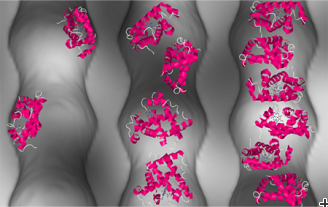Copyright 2012 neutronsources.org | All rights reserved. | Powered by FRM II | Imprint / Privacy Policy
Preventing Clumping: How to Keep Proteins Active
Date:19/12/2018
Source: FZ Jülich
Protein molecules are nature’s all-rounders and carry out their specific tasks with great efficiency. For example, some play an important role in converting substances; others are involved in combatting pathogens. As a result, these biological machines are important in technical as well as medical applications. However, proteins tend to clump together irreversibly at high concentrations and thus lose their effectiveness, although this only occurs when they are outside their natural environment of the cell’s interior.
Spatial restrictions can maintain the activities of concentrated protein solutions. Just why this happens has until now been poorly understood. Scientists at Forschungszentrum Jülich and University College London have now demonstrated for the first time that despite high concentration levels, proteins do not clump together in nanocavities of porous silicon dioxide, but instead behave like a fluid. The scientists discovered that crucial to this behaviour are on the one hand the interactions between the proteins and the interface, and on the other, the curvature of the nanopores.
Small-angle neutron scattering at one of the Jülich installations at the Heinz Meier-Leibnitz Zentrum in Garching has enabled the researchers to directly identify the arrangement of the proteins tested, myoglobin and lysozyme, through the nanostructured materials. In doing so, the researchers showed that the method enables connections between the characteristics of the pores, the arrangement of the proteins and their activity to be revealed. The knowledge gained can be used for the development of new and better bioinspired applications in biotechnology, medicine and catalytic processes.
Original publication:
Confinement Facilitated Protein Stabilization As Investigated by Small-Angle Neutron Scattering;
Justin Siefker, Ralf Biehl, Margarita Kruteva, Artem Feoktystov, Marc-Olivier Coppens;
J. Am. Chem. Soc. 2018, 140, 40, 12720-12723, DOI: 10.1021/jacs.8b08454
